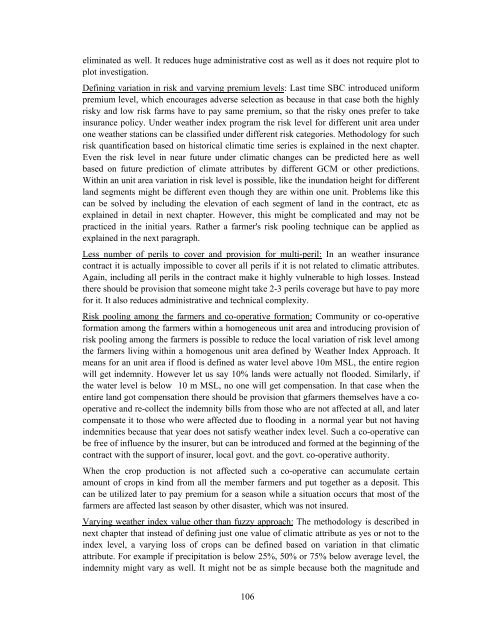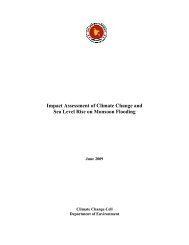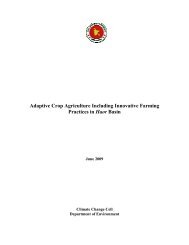Crop Insurance as a Risk Management Strategy in Bangladesh
Crop Insurance as a Risk Management Strategy in Bangladesh
Crop Insurance as a Risk Management Strategy in Bangladesh
Create successful ePaper yourself
Turn your PDF publications into a flip-book with our unique Google optimized e-Paper software.
elim<strong>in</strong>ated <strong>as</strong> well. It reduces huge adm<strong>in</strong>istrative cost <strong>as</strong> well <strong>as</strong> it does not require plot to<br />
plot <strong>in</strong>vestigation.<br />
Def<strong>in</strong><strong>in</strong>g variation <strong>in</strong> risk and vary<strong>in</strong>g premium levels: L<strong>as</strong>t time SBC <strong>in</strong>troduced uniform<br />
premium level, which encourages adverse selection <strong>as</strong> because <strong>in</strong> that c<strong>as</strong>e both the highly<br />
risky and low risk farms have to pay same premium, so that the risky ones prefer to take<br />
<strong>in</strong>surance policy. Under weather <strong>in</strong>dex program the risk level for different unit area under<br />
one weather stations can be cl<strong>as</strong>sified under different risk categories. Methodology for such<br />
risk quantification b<strong>as</strong>ed on historical climatic time series is expla<strong>in</strong>ed <strong>in</strong> the next chapter.<br />
Even the risk level <strong>in</strong> near future under climatic changes can be predicted here <strong>as</strong> well<br />
b<strong>as</strong>ed on future prediction of climate attributes by different GCM or other predictions.<br />
With<strong>in</strong> an unit area variation <strong>in</strong> risk level is possible, like the <strong>in</strong>undation height for different<br />
land segments might be different even though they are with<strong>in</strong> one unit. Problems like this<br />
can be solved by <strong>in</strong>clud<strong>in</strong>g the elevation of each segment of land <strong>in</strong> the contract, etc <strong>as</strong><br />
expla<strong>in</strong>ed <strong>in</strong> detail <strong>in</strong> next chapter. However, this might be complicated and may not be<br />
practiced <strong>in</strong> the <strong>in</strong>itial years. Rather a farmer's risk pool<strong>in</strong>g technique can be applied <strong>as</strong><br />
expla<strong>in</strong>ed <strong>in</strong> the next paragraph.<br />
Less number of perils to cover and provision for multi-peril: In an weather <strong>in</strong>surance<br />
contract it is actually impossible to cover all perils if it is not related to climatic attributes.<br />
Aga<strong>in</strong>, <strong>in</strong>clud<strong>in</strong>g all perils <strong>in</strong> the contract make it highly vulnerable to high losses. Instead<br />
there should be provision that someone might take 2-3 perils coverage but have to pay more<br />
for it. It also reduces adm<strong>in</strong>istrative and technical complexity.<br />
<strong>Risk</strong> pool<strong>in</strong>g among the farmers and co-operative formation: Community or co-operative<br />
formation among the farmers with<strong>in</strong> a homogeneous unit area and <strong>in</strong>troduc<strong>in</strong>g provision of<br />
risk pool<strong>in</strong>g among the farmers is possible to reduce the local variation of risk level among<br />
the farmers liv<strong>in</strong>g with<strong>in</strong> a homogenous unit area def<strong>in</strong>ed by Weather Index Approach. It<br />
means for an unit area if flood is def<strong>in</strong>ed <strong>as</strong> water level above 10m MSL, the entire region<br />
will get <strong>in</strong>demnity. However let us say 10% lands were actually not flooded. Similarly, if<br />
the water level is below 10 m MSL, no one will get compensation. In that c<strong>as</strong>e when the<br />
entire land got compensation there should be provision that gfarmers themselves have a cooperative<br />
and re-collect the <strong>in</strong>demnity bills from those who are not affected at all, and later<br />
compensate it to those who were affected due to flood<strong>in</strong>g <strong>in</strong> a normal year but not hav<strong>in</strong>g<br />
<strong>in</strong>demnities because that year does not satisfy weather <strong>in</strong>dex level. Such a co-operative can<br />
be free of <strong>in</strong>fluence by the <strong>in</strong>surer, but can be <strong>in</strong>troduced and formed at the beg<strong>in</strong>n<strong>in</strong>g of the<br />
contract with the support of <strong>in</strong>surer, local govt. and the govt. co-operative authority.<br />
When the crop production is not affected such a co-operative can accumulate certa<strong>in</strong><br />
amount of crops <strong>in</strong> k<strong>in</strong>d from all the member farmers and put together <strong>as</strong> a deposit. This<br />
can be utilized later to pay premium for a se<strong>as</strong>on while a situation occurs that most of the<br />
farmers are affected l<strong>as</strong>t se<strong>as</strong>on by other dis<strong>as</strong>ter, which w<strong>as</strong> not <strong>in</strong>sured.<br />
Vary<strong>in</strong>g weather <strong>in</strong>dex value other than fuzzy approach: The methodology is described <strong>in</strong><br />
next chapter that <strong>in</strong>stead of def<strong>in</strong><strong>in</strong>g just one value of climatic attribute <strong>as</strong> yes or not to the<br />
<strong>in</strong>dex level, a vary<strong>in</strong>g loss of crops can be def<strong>in</strong>ed b<strong>as</strong>ed on variation <strong>in</strong> that climatic<br />
attribute. For example if precipitation is below 25%, 50% or 75% below average level, the<br />
<strong>in</strong>demnity might vary <strong>as</strong> well. It might not be <strong>as</strong> simple because both the magnitude and<br />
106





